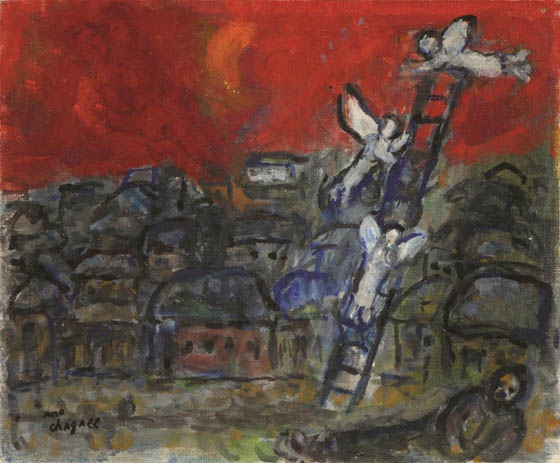

NEW YORK — For the first time in over two decades a painting by Marc Chagall will be going up for auction in Israel. Tiroche Auction House will be hosting the Israeli & International Art auction on January 25th – featuring paintings by a number of Israeli masters, including Reuben Rubin, and Yosl Bergner. The highlight of the evening however is Chagall’s Jacob’s Ladder (1970-1974), a theme to which the artist would return at least a dozen times in paintings and drawings.
Chagall was born in 1887 to a Lithuanian Hasidic Jewish family near the city of Vitebsk, then part of the Russian Empire. He would later say in an open letter “To my City Vitebsk”: “I did not live with you, but I didn’t have one single painting that didn’t breathe with your spirit and reflection.”
Relocating to Paris in 1910, Chagall would soak up the latest developments in painting – including Cubism, which was dominant at the time. And in 1931 he would travel to the Holy Land, remaining there for two months. It is well known that Eugène Delacroix’s travels through North Africa would have a transformative effect on his art. Chagall’s visit to Palestine would also prove to have a decisive influence. But unlike Delacroix, Chagall was a Jew returning to the land of his ancestors. As one biographer puts it, “What he was really searching for there was… an inner authorization… to plunge into his work on the Bible illustrations.”
For Chagall, the Hebrew Bible was chiefly a ‘human story,” and with these illustrations Chagall had shown himself – not for the first time – to be one of the 20th century’s most significant visual artists. “I did not see the Bible, I dreamed it,” he once conveyed to a friend. Perhaps this is one reason why Chagall was attracted to the story of Jacob and his Ladder, which, after all, appears to the patriarch in a dream.
The story comes in Genesis 28:10-19. Jacob is fleeing from his brother Esau, making his way toward Haran. As the sun sets he gathers some stones to place under his head and falls asleep. In his dream Jacob sees a “ladder set up on the earth, and the top of it reached to heaven; and behold the angels of God ascending and descending on it.” God appears to Jacob in his dream and reaffirms the covenant made with Abraham and Isaac, and assures Jacob that his descendants will inherit the land. When Jacob awakens he proclaims, “How full of awe is this place! This is none other than the house of God, and this is the gate of heaven.” The next day Jacob builds a kind of monument to honor the place, which he names Beit El (“House of God”).
There are of course many and varied interpretations of this Biblical episode, which great artists – from Rembrandt to J.M.W. Turner – have re-imagined. According to Rashi, the place where Jacob tarried for the night was in fact none other than Mount Moriah – the site at which Isaac was bound, and the future Temple would be erected – an interpretation to which Turner perhaps alluded with the rugged mountainous landscape of his 1830 depiction.
In the picture up for auction, Chagall has rendered the scene in his characteristically naïve style. In the forefront – the bottom right corner – Jacob sleeps. Just behind him, in the middle ground, is the humble ladder, straight and narrow that three angels in white grasp and flit about. One might compare, by way of contrast, Chagall’s ladder to the grand, celestially winding stairway of William Blake’s vision from 1805. Chagall offers us a ladder more akin to Rembrandt’s – a ladder such as one might find beside a simple house in the small peaceful village that stretches in the background.
The presence of a village in the scene was unusual to the say the least – earlier artists invariably depicted Jacob alone, in the wilderness. Chagall’s village of course invokes on the one hand his hometown of Vitebsk, which is a part in some way of “[every] single painting” he made. But it is also speaks to the promise that God makes to Jacob: “The land whereon thou liest, to thee will I give it, and to thy seed. And thy seed shall be as the dust of the earth, and thou shalt spread abroad to the west, and to the east, and to the north, and to the south.”
From the deep red of the sky to the blue tinged roofs of the village, we see Chagall’s utter mastery of color. It is little wonder that Picasso once observed: “When Matisse dies, Chagall will be the only painter left who understands what colour really is.” This painting is a reminder that while he learned from Cubism, Symbolism, Fauvism and Surrealism, as the historian E. H. Giombrich observed, Chagall “did not allow his acquaintance with modern experiments to blot out his childhood memories.” To be an artist is in some measure to be able to see the world the way we did as children – with that child-like sense of wonder and awe. As this rendering of Jacob’s Ladder reveals, of no painter is this more true than Marc Chagall.
*
Sam Ben-Meir, PhD, is a professor of philosophy and world religions at Mercy College in New York City.